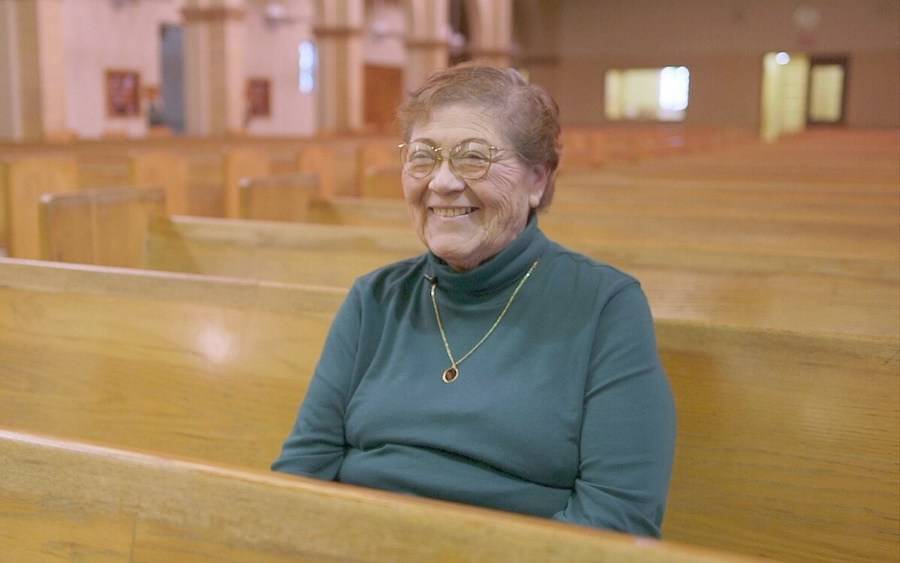Novel Knee Surgery Returns Local Nun to Her 30th Anniversary of Ministry
Protégé of Mother Teresa says robotic surgery is heaven sent

Sister Margaret Castro at St. Rita's Catholic Church
Protégé of Mother Teresa says robotic surgery is heaven sent
After devoting her life to caring for others, including work with the recently sainted Mother Teresa to help lepers in India, Sister Margaret Castro was sidelined by excruciating knee pain.
But the energetic 78-year-old nun recently resumed her longtime ministry at St. Rita’s Catholic Church in Southeast San Diego, thanks in part to a novel surgical technology she says is heaven sent. This June, Castro celebrates her 30-year anniversary of service at St. Rita’s, where she leads the religious education program and other outreach efforts.
New approach offers advantages
The robotic technology, approved last year by the Food and Drug Administration for total knee replacement, enabled Scripps surgeon David Fabi, MD, to capture a 3-D digital picture of the bones and tissue inside the nun’s right knee. Using this picture, the NAVIO surgical system identified where Dr. Fabi should cut to precisely align the knee replacement, providing similar rotation and flexibility to what Castro remembers having in her natural knee.
“It’s wonderful when we are able to help people return to their active lifestyle with this surgery,” Fabi said. “It’s extra special when we can get a public servant like Sister Margaret back on her feet, because she means so much and gives so much to the community.”
Sidelined by excruciating pain
Castro was using a cane and coping with unrelenting pain and grinding in her right knee as she walked the hallways and climbed stairs at the church’s elementary school to visit religious education classes.
On weekdays, just to get to her second-floor office, Castro must climb 21 steps. She’s up and down those stairs several times daily when visiting sick parishioners, going to daily prayer service, attending community meetings or directing the church choir.
The pain eventually became unbearable for Castro, who is well-acquainted with physical hardship — she regularly trekked through the slums of India as a young nun, serving 15 years with her mentor, then known as Mother Teresa, and rode a motorcycle through the narrow streets of Malawi during a three-year mission to attend to the sick there.
About 15 years ago, a stack of tables in the St. Rita’s school cafeteria fell, crashing into Castro’s left knee before falling onto her right knee. Her left knee had to be replaced immediately. And when the pain grew unbearable in her right knee last December, she went to see Dr. Fabi.
“When the doctor told me about the robotic surgery, I thought ‘Why not? That sounds great,’” said Castro, a San Diego native. “And it’s worked out great so I’ve referred several other people to the doctor for the same surgery.”
A look at robotic technology
Unlike other robotics-assisted platforms, the NAVIO technology does not require a pre-operative CT scan. Instead, the surgeon collects patient-specific data during the procedure through tiny sensors placed on the patient’s knee and leg bones, which feed data to the computer.
“The 3-D modeling robotic surgery system increases the accuracy and precision of total knee replacement surgery to as close to 100 percent as possible,” Dr. Fabi said. Earlier generation computer navigation systems only provided data on how to make cuts to the bone in the joint, he said. “This new technology helps me achieve my goal of what I call ‘one and done,’ meaning one surgery for the rest of the patient’s life and to provide a ‘home run’ knee replacement for the patient.”
The road to recovery
A few hours after Castro’s surgery, a physical therapist at Scripps Mercy Hospital had her walking down the hallway and up a flight of stairs with the help of a walker. Days later, she went to the convent where she stayed for three weeks, receiving care and encouragement from the nuns and regular visits from a physical therapist. After three weeks, she returned to work at St. Rita’s, climbing stairs, walking school hallways and visiting classrooms.
“Total knee replacement is a game of millimeters and incremental degrees,” Dr. Fabi said. “It’s important to get as close to 100 percent accuracy as possible in placing the prosthetic knee so that it feels as natural as possible to the patient.”
San Diego's orthopedic care leader
Scripps performs more orthopedic surgeries than any other health system in San Diego County, and about 1,500 of those procedures each year are total knee replacements. About 719,000 total knee replacement surgeries are performed in the United States each year, according to the Centers for Disease Control and Prevention.
Scripps is ranked among the nation’s best for orthopedic care by U.S. News & World Report. The standing is based on key metrics such as quality, patient outcomes and system capabilities and facilities.
Scripps orthopedic doctors, surgeons and clinicians are recognized experts for treating sports injuries, as well as other complex conditions that may require a knee replacement, hip replacement, spinal fusion or procedure for the neck, shoulders, elbow, wrists, hands, ankles and feet.
Learn more about Scripps Health, a nonprofit integrated health system in San Diego, Calif.
Media Contact
- Steve Carpowich
- 858-312-0328
- carpowich.stephen@scrippshealth.org
- Follow me: @Carpowich